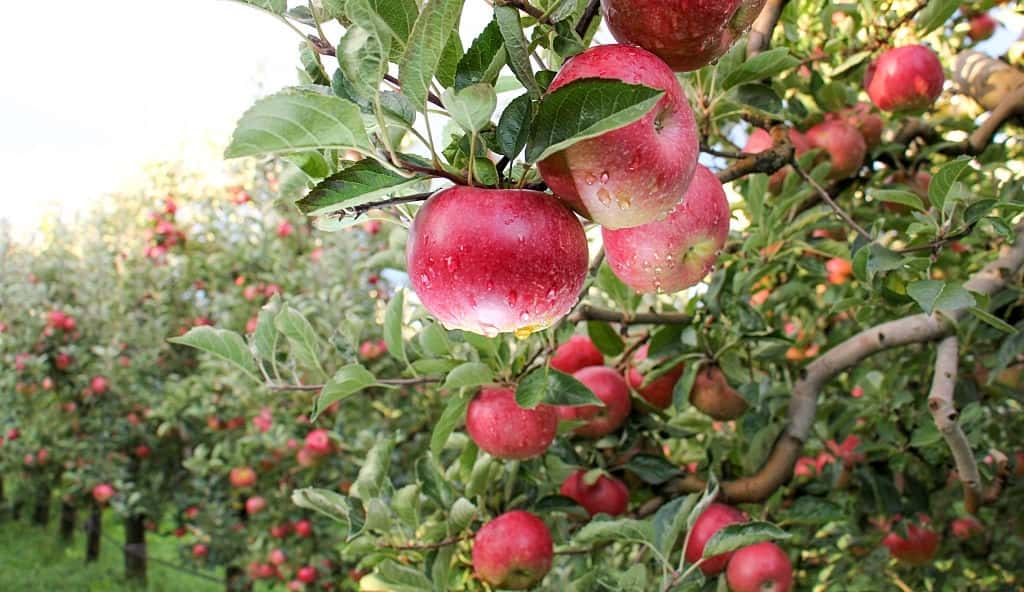Crab apple trees, with their stunning blooms, attractive fruits, and versatile uses, are a wonderful addition to any garden. Known for their resilience and ornamental charm, crab apple trees are a popular choice for British gardens, offering year-round beauty and value. Beyond their visual appeal, these trees also support wildlife, help with pollination of other fruiting trees, and produce fruits that can be used in a variety of ways. However, growing crab apple trees to their full potential requires knowledge of the best varieties, planting techniques, and ongoing care.
This article provides comprehensive tips on growing and caring for crab apple trees, ensuring they flourish and add beauty to your garden. From planting and pruning to choosing the right variety, every aspect of crab apple gardening is covered to help you create a thriving and beautiful space.
A nursery specialist at ChrisBowers offers valuable insight: “The beauty of crab apple trees lies not only in their striking blossoms but also in their utility as pollinators and their value to wildlife. When selecting a variety, it’s important to consider both aesthetics and function—whether you’re looking to attract bees, improve the yield of your apple trees, or enjoy their colourful autumn fruits. Always match the variety to your local conditions for the best results.”
Why Choose Crab Apple Trees for Your Garden?
Crab apple trees are a wonderful choice for British gardens, and they serve many purposes beyond being mere decorative features. These small to medium-sized trees are perfect for urban and rural environments alike, providing beauty through every season. In spring, they burst into bloom with clouds of pink, white, or red blossoms that attract bees and other pollinators. During summer, the glossy leaves create a dense canopy, and by autumn, the small, jewel-like fruits ripen in shades of yellow, orange, and red, providing both colour and food for birds.
One of the main reasons gardeners are drawn to crab apple trees is their adaptability. They thrive in various soil types, from sandy to clay, and can handle the UK’s often unpredictable weather conditions. Moreover, their relatively small size makes them perfect for smaller gardens where space is limited but interest is desired.
Crab apples are also valuable as pollinators for other fruiting trees, particularly apple trees. Many varieties produce an abundance of blossoms that overlap with the blooming period of apple trees, making them excellent partners in orchards. The plentiful flowers of crab apple trees help ensure that bees have plenty of pollen to transfer between trees, improving fruit yields.
Selecting the Right Crab Apple Variety for Your Garden
Choosing the right crab apple tree is the first step toward creating a beautiful and productive garden. There are numerous varieties of crab apple trees, each with its own unique features, such as flower colour, fruit size, and growth habit. Understanding the key differences can help you choose the best tree for your needs.
For gardeners seeking a show-stopping spring display, varieties like ‘Evereste’ or ‘John Downie’ are excellent choices. ‘Evereste’ is noted for its profusion of white blossoms tinged with pink, while ‘John Downie’ produces large white flowers followed by orange-red fruits. These trees are not only stunning but also highly effective pollinators, making them a practical addition to gardens with other fruit trees.
For those interested in attracting wildlife, ‘Golden Hornet’ is a superb option. This variety produces masses of small yellow fruits that persist into winter, providing an essential food source for birds. ‘Golden Hornet’ also adds ornamental value through its long-lasting fruit, which contrasts beautifully with the bare branches during the colder months.
If you prefer a compact tree that fits well into smaller spaces, ‘Butterball’ is an excellent choice. This variety remains relatively small, making it ideal for urban gardens or limited spaces. It produces beautiful cream-coloured blossoms that develop into small, butter-yellow fruits, adding both aesthetic and ecological value to the garden.
Planting Your Crab Apple Tree: Tips for Success
Planting a crab apple tree correctly is crucial for ensuring its long-term health and productivity. These trees thrive when planted in a location that provides full sun, although they can tolerate partial shade. However, for the best flowering and fruiting, a sunny spot is recommended.
Although they may grow in a variety of soil conditions, crab apple trees prefer rich, well-drained soil that is pH-neutral to slightly acidic (6.0–7.0). It is a good idea to amend the soil before planting, using compost or well-rotted manure to help retain moisture without waterlogging and give vital nutrients.
When preparing the planting site, dig a hole that is twice as wide as the root ball and deep enough to allow the roots to spread naturally. Placing the tree in the hole, be sure that the graft union—the point where the scion (the upper fruiting part of the tree) is joined to the rootstock—remains above the soil line. This prevents the scion from rooting and ensures the tree maintains the characteristics dictated by its rootstock.
Watering is essential during the first year after planting. Newly planted trees require consistent moisture to establish their root systems, especially during dry spells. Deep watering, rather than frequent shallow watering, encourages the roots to grow down into the soil, which will ultimately create a stronger, more drought-resistant tree.
Mulching around the base of the tree with organic matter such as bark or straw helps conserve moisture, suppress weeds, and maintain soil temperature. However, keep the mulch a few inches away from the trunk to avoid rot and prevent pests from finding shelter close to the base of the tree.
Ongoing Care: Pruning and Fertilising Crab Apple Trees
Pruning is a key aspect of caring for crab apple trees, helping maintain their shape, improve air circulation, and enhance flower and fruit production. Pruning should be done in late winter or early spring, before the tree starts to put on new growth. The goal is to create an open, vase-like structure that allows sunlight to reach the centre of the tree, which reduces the risk of fungal diseases and promotes healthy fruiting.
Young trees should be pruned to establish a strong framework of branches. This formative pruning helps develop a balanced structure that can support heavy blooms and fruit later in life. Once the tree is mature, maintenance pruning involves removing any dead, diseased, or damaged wood, as well as thinning out crowded branches to keep the canopy open.
Fertilising crab apple trees ensures they have the nutrients needed for robust growth and fruit production. An annual application of a balanced fertiliser in early spring provides essential nutrients like nitrogen, phosphorus, and potassium. Crab apples benefit from organic matter being incorporated into the soil around the tree, which improves soil fertility and structure. However, over-fertilisation should be avoided, as too much nitrogen can lead to excessive leafy growth at the expense of flowers and fruit.
Dealing with Pests and Diseases
Crab apple trees, like all fruit trees, can be susceptible to certain pests and diseases. Common issues include aphids, apple scab, and powdery mildew. Fortunately, with proper care and attention, many of these problems can be managed effectively.
Aphids are small, sap-sucking insects that can cause leaves to curl and stunt new growth. Ladybirds and lacewings are natural predators of aphids and can help keep populations in check. Alternatively, insecticidal soaps can be used to control severe infestations. Regularly inspecting your tree for aphids, especially during the spring, helps prevent their populations from getting out of control.
Apple scab is a fungal disease that affects both the leaves and fruit, leading to unsightly blemishes and reduced fruit quality. To manage apple scab, it is important to ensure good air circulation through proper pruning, which helps keep the leaves dry and reduces the spread of fungal spores. Some crab apple varieties, such as ‘Evereste’ and ‘Golden Hornet,’ have been bred for resistance to apple scab, making them a good choice for those looking to avoid this common issue.
Powdery mildew is another fungal problem that can affect crab apples, particularly in warm, dry conditions. It appears as a white powdery coating on leaves and shoots. Removing affected growth and ensuring the tree is properly pruned to allow for good air circulation are effective measures for reducing powdery mildew.
The Role of Crab Apple Trees in Supporting Wildlife
Crab apple trees are more than just beautiful garden features—they play an important role in supporting local wildlife. Their spring blossoms are a rich source of nectar and pollen for bees and other pollinators, which are crucial for maintaining biodiversity and supporting the productivity of other fruit trees in the garden.
The small fruits produced by crab apple trees are a valuable food source for birds, particularly during the colder months when other food sources may be scarce. Varieties like ‘Golden Hornet’ retain their fruit well into winter, providing sustenance for thrushes, blackbirds, and other garden birds. The fruits can also be harvested by the gardener and used to make jellies, cider, or added to cooking for a tart flavour.
Planting crab apple trees can thus contribute significantly to creating a garden that is not only beautiful but also ecologically balanced. By providing food and habitat for pollinators and birds, these trees help maintain a healthy garden ecosystem.
Harvesting Crab Apples: Culinary Uses
Crab apples are not typically eaten fresh due to their sour taste, but they are highly valued for culinary uses. The small fruits can be harvested in autumn and used in a variety of ways. Crab apple jelly is one of the most popular uses, providing a tangy, brightly coloured spread that pairs well with both sweet and savoury dishes.
Crab apples can also be used to make cider, either on their own or blended with other apple varieties to add complexity to the flavour. Their high pectin content makes them perfect for adding to other jams and jellies to help them set properly.
Harvesting crab apples is simple—once the fruits are firm and brightly coloured, they are ready to be picked. For the best flavour, wait until after the first frost, which tends to soften the fruit’s acidity slightly and enhance its natural sweetness.
Finding Quality Crab Apple Trees for Sale
When looking for “fruit trees for sale,” it’s important to select high-quality trees from a reputable nursery. Healthy crab apple trees that are well-cared-for from the beginning are more likely to thrive once transplanted to your garden. Nurseries like ChrisBowers provide detailed information about the varieties available, including flowering times, fruiting characteristics, and disease resistance.
Quality is paramount when selecting any fruit tree. A well-formed tree with a strong central leader, good branching, and a healthy root system is essential for long-term success. Bare-root trees, often available during the winter planting season, are a cost-effective option that can establish well if planted and cared for properly.
Conclusion: Creating a Beautiful and Productive Garden with Crab Apple Trees
Crab apple trees are a versatile and rewarding addition to any garden. Their year-round interest, from spring blossoms to autumn fruits, combined with their ability to support pollinators and wildlife, makes them an excellent choice for gardeners looking to enhance both the beauty and biodiversity of their space. By carefully selecting the right variety and providing proper planting, pruning, and care, you can ensure that your crab apple tree flourishes, bringing years of enjoyment and utility.
Whether you’re looking to boost the pollination of other fruit trees, add ornamental beauty, or support garden wildlife, crab apple trees can transform your garden into a thriving and vibrant oasis. By purchasing quality “fruit trees for sale” from a trusted nursery and following best practices in care, you will be well on your way to enjoying the many benefits that these charming trees provide.

